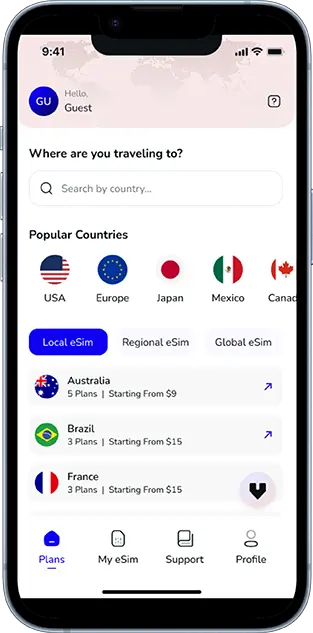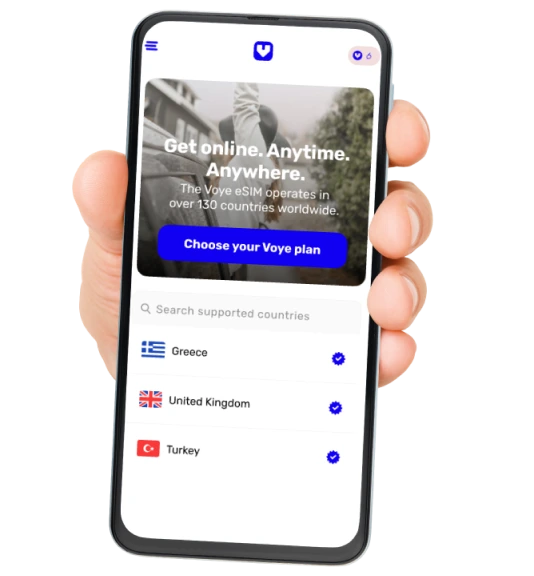Note that iPhone devices from Mainland China aren’t eSIM compatible. Also iPhone devices from Hong Kong and Macao aren’t compatible (except for iPhone 13 Mini, iPhone 12 Mini, iPhone SE 2020 and iPhone XS)
Planning a trip to Greece? From the bustling streets of Athens to the serene Cycladic islands, one thing is clear: navigating the country efficiently can make or break your travel experience. Greece has a surprisingly extensive transportation network—one that’s a mix of modern metros, scenic ferries, and local quirks. In this blog, we break down everything you need to know about transportation in Greece, so you can explore the mainland and islands without stress.
Mainland Transportation: Getting Around Athens and Beyond
Athens Metro: Fast, Reliable & Surprisingly Modern
Athens has one of the most efficient metro systems in Europe. Clean, air-conditioned, and affordable, the metro is a favorite among both locals and tourists.
Lines and Coverage:
- Line 1 (Green): Connects Piraeus Port to Kifisia.
- Line 2 (Red): Runs from Anthoupoli to Elliniko—great for reaching the Acropolis.
- Line 3 (Blue): Connects the city center to Athens International Airport.
Tickets & Pricing (2025 Rates):
- Single ticket (90 min): €1.20
- 24-hour ticket: €4.10
- 5-day unlimited: €8.20
- Airport metro ticket: €9.00
Tip: Use contactless cards or get the ATH.ENA card for reloading and discounts.
Buses & Trolleys in Athens
Athens is serviced by an extensive network of blue buses and yellow electric trolleys.
Good to Know:
- Operate from early morning until midnight.
- Night buses are available on key routes.
- Tickets are the same as metro and must be validated upon boarding.
Intercity Buses (KTEL)
If you’re heading from Athens to towns like Nafplio, Delphi, or Meteora, KTEL buses are your best bet.
Benefits:
- Affordable and reliable.
- Air-conditioned with frequent departures.
- Ideal for regions not serviced by trains.
Popular Routes:
- Athens to Delphi: ~3 hours
- Athens to Meteora: ~5 hours
- Thessaloniki to Halkidiki: ~2 hours
Greece’s Train Network: Scenic but Limited
Train travel in Greece is operated by Hellenic Train (formerly TrainOSE). While not as extensive as in other European countries, trains are useful for routes like:
- Athens to Thessaloniki: 4–5 hours on Intercity trains.
- Athens to Kalambaka (Meteora): 4.5–5 hours with a transfer in Paleofarsalos.
When to Choose Trains:
- You want a comfortable ride with views.
- Traveling between Athens and Northern Greece.
- Booking in advance for lower fares.
Greek Ferry System: Your Gateway to the Islands
One of the most iconic aspects of Greece travel is ferry hopping. The ferry system connects hundreds of islands across the Aegean and Ionian Seas.
Major Ferry Ports:
- Piraeus (Athens): Main hub for the Cyclades (Santorini, Mykonos, Paros).
- Rafina: Closer to the airport; good for Andros, Tinos.
- Heraklion (Crete): Serves Santorini, Ios, and mainland Greece.
- Patras: Western Greece port, ideal for ferries to Italy.
Ferry Types:
- Conventional Ferries: Cheaper, slower, spacious.
- High-Speed Ferries: More expensive but cuts travel time by 30–50%.
- Catamarans: Great for short hops between nearby islands.
Average Ferry Times (From Piraeus):
- Santorini: 5–8 hours
- Mykonos: 2.5–5 hours
- Paros: 3–4 hours
- Crete: 6–9 hours
Booking Tips:
- Use websites like Ferryhopper or Direct Ferries.
- Book early in peak season (June–September).
- Always arrive 45–60 mins before departure.
- Watch for weather cancellations, especially with smaller catamarans.
Save More on Your Greece Adventure
Use code VOYE15 at checkout to get 15% off your Greece eSIM
Domestic Flights: Time vs Cost
Flying within Greece makes sense for longer routes like:
- Athens to Crete
- Thessaloniki to Rhodes
- Athens to Corfu
Airlines to Consider:
- Aegean Airlines
- Sky Express
- Olympic Air
Flights are short (30–60 mins), but delays aren’t uncommon. Ferries are more scenic, but flights save time for longer routes.
Your Journey, Our eSIM
Stay online abroad with instant activation.
Local Transportation on Islands: Scooters, ATVs & Buses
Once you’re on an island, how do you get around?
Public Buses
Most islands like Santorini, Naxos, and Paros have reliable local bus services.
Pros:
- Cheap (€1.60–€2.50 per ride)
- Operates from morning to late evening
- Covers main beaches and towns
Rental Scooters & ATVs
- Ideal for small islands or beach hopping.
- Average rental: €20–€35 per day (scooter), €40+ (ATV).
- Requires valid international driving license (check local rules).
Taxis & Ride-Sharing
- Taxis are available on most major islands but can be expensive.
- No Uber or Lyft in most areas—some islands use local taxi apps like Taxiplon (Athens) or island-specific dispatchers.
Renting a Car in Greece: Do You Need One?
If you’re planning to explore the Peloponnese, Northern Greece, or less touristy islands like Ikaria or Kefalonia, a car is essential.
Requirements:
- International Driving Permit (for non-EU travelers)
- Minimum age: 21–23 depending on the provider
- Deposit: Usually €300–€800
Tip: Avoid renting in central Athens unless you’re heading out of the city. Traffic and parking are a nightmare.
Luggage Tips for Public Transport
- Metro & Ferries: Carry smaller bags or backpacks for easy movement.
- Buses & Trains: Store larger luggage under the bus or in the cargo carriage.
- Island Travel: Wheels + ferry decks = a pain. Go with a backpack if you can.
Sample Travel Routes Using Smart Transport
Route 1: Athens → Mykonos → Paros → Santorini
- Use the metro to reach Piraeus, ferry hop through the Cyclades.
Route 2: Thessaloniki → Meteora → Delphi → Athens
- Train + KTEL buses offer an easy loop.
Route 3: Athens → Naxos → Crete (Heraklion or Chania)
- Ferry from Piraeus → Naxos → overnight ferry or flight to Crete.
No Roaming, Just Exploring
Get seamless mobile data in Greece. Save 15% with code VOYE15.
Stay Connected on the Move with Voye Global eSIM
Whether you’re checking ferry schedules, hailing a local taxi, or navigating narrow island roads, staying connected is key. With Voye Global’s Greece eSIM, you can:
- Use Google Maps, translation apps, and travel guides without interruption.
- Skip SIM card lines at the airport.
- Instantly activate high-speed data.
FAQs: Greece Transportation Tips
Is the metro in Athens easy to use?
Yes, it’s tourist-friendly with English signage and color-coded lines. Google Maps works well with it.
How do I get from Athens to Santorini?
You can take a ferry from Piraeus (5–8 hrs) or fly (45 mins).
Are Greek ferries reliable?
Mostly yes, but high winds can cause delays—especially in the Cyclades.
Can I use Uber in Greece?
Uber operates in Athens as a licensed taxi aggregator. On islands, use local taxi apps or call dispatch.
What’s the best way to island hop in Greece?
Ferries are scenic and flexible. For long distances, consider flights with Aegean or Sky Express.
Do I need an international license to rent a car or scooter?
Yes, especially if you’re from the US, Australia, or other non-EU countries.
Final Travel Tips for Getting Around Greece
- Use the ATH.ENA card in Athens for all local transport.
- Book ferry tickets early in summer (July–August).
- Double-check ferry ports—Piraeus has multiple gates.
- Pack light if you’re ferry hopping.
- Always check local bus schedules—they change per season.
- Stay connected with a Voye Global eSIM to access Google Maps, taxi apps, and last-minute bookings.
Don’t Let Roaming Charges Hold You Back
Travel Greece with fast, affordable data.
Seamless Mobile Data Everywhere
















